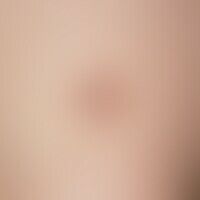Image diagnoses for "brown"
357 results with 1404 images
Results forbrown

Melanodermatitis toxica L81.4
Melanodermatitis toxica. solitary, chronically stationary (no growth dynamics), large-area, blurred, asymptomatic (only cosmetically disturbing), brown, smooth spot. pronounced solar damage to the skin.

Nevus verrucosus Q82.5
Naevus verrucosuswith bizarre arrangement of brownish papules and plaques along the Blaschko lines.

Melanoma acrolentiginous C43.7 / C43.7
melanoma malignes acrolentiginous. dark discoloration of the right small toe existing for years. growth of thickness for 1/2 year, discoloration increasingly decreasing. now: largely amelanotic, centrally ulcerated and macerated nodule at the 5th toe. remark: treated as mycosis for several months.

Purpura anularis teleangiectodes L81.7
Purpura anularis teleangiectodes: brown-red anular, also cocard-like (ring-in-ring structure) by confluence also serpiginous foci. no significant itching. sporadically also largely faded only shadowy spots.

Melanoma acrolentiginous C43.7 / C43.7
Melanoma, malignant, acrolentiginous, subungual and paraungual, black pigmented tumor in the fingernail area, advanced stage with destruction of the nail.

Keratosis palmoplantaris striata with mutations in desmoglein 1 Q82.8

Melanoma acrolentiginous C43.7 / C43.7
Mlelanom malignes acrolentiginous: Subungual malignant melanoma. Characteristic is the stripy growth through the entire length of the nail. The arrow marks the so-called Hutchinson sign.

Dermatofibroma D23.-
Dermatofibroma: a coarse tumour with pigmented edges that protrudes above the skin level.

Nevus melanocytic congenital D22.-
Congenital melanocytic nevus. Brown, soft plaque sharply delineated from surrounding normal skin. Hypertrichosis.

Circumscribed scleroderma L94.0
Circumscript scleroderma: profound circumscript scleroderma (deep morphea); rare subtype of circumscript scleroderma (<5% of patients); nodular indurations in the subcutaneous fatty tissue were found.

Porokeratosis mibelli Q82.8
Porokeratosis Mibelli. gradually progressive finding with solitary, 0.1-0.2 cm large, symptom-free, yellow-brown horny papules (primary lesion), which have been present for years. As shown here, they show surface and thickness growth. On the back of the foot the papules have (coincidentally) merged into a coarse plaque with a spiny surface.

Granuloma anulare disseminatum L92.0

Borrelia lymphocytoma L98.8
Lymphadenosis cutis benigna: brownish, bulging elastic, painless, moderately sharply defined lump, since 6 months, in the facial area in children.

Ringworm B35.2
Tinea manuum:For a long time now, this large-area, temporarily itchy plaque, accentuating the edges of the forearm, has been present in the 42-year-old patient (no pre-treatment).

Porokeratosis superficialis disseminata actinica Q82.8
Porokeratosis superficialis disseminata actinica: disseminated, brownish-yellowish, sharply defined, hyperkeratotic nodules/plaques localized on the extensor sides; clear actinic damage to the skin with multiple lentigines.

Cheilitis granulomatosa G51.2

Melanodermatitis toxica L81.4
Melanodermatitis toxica: detailed image with the upper bizarre demarcation line to the unaffected skin.







